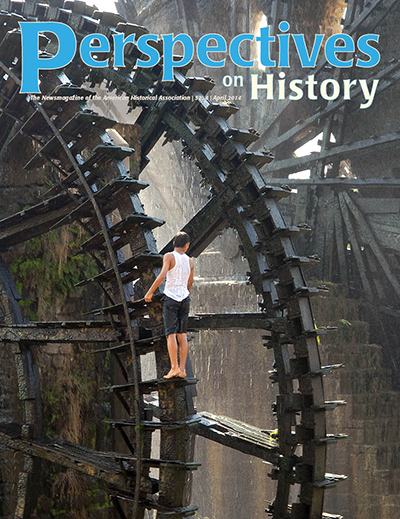
Features
- My New Attendance Policy
Jonathan Ablard | Apr 1, 2014
- Teaching with a Tea Set
Abby Chandler | Apr 1, 2014
On the Cover
Waiting for the Right Moment," by Ammar Abd Rabbo, was taken in 2007 in Hama, Syria.
In the Byzantine era, enormous water wheels were built on the Orontes River as part of an aqueduct system. In the medieval period, 30 norias were documented; today 17 norias that were built in the Ayyubid period remain in the city of Hama.
Photographer Abd Rabbo writes, "The kids of Hama like to stand on the wheel, get 'lifted' with it, and then jump in the waters of the river Orontes. The game is 'free' and seems like great fun, especially in the hot summers of Hama." Abd Rabbo imagines the youngsters of Hama diving from the norias for generations and generations.
Abd Rabbo stresses that historic artifacts are part of everyday life in Syria. "Families would picnic on the grass of Aleppo Citadel, kids would run in ancient mosques," he wrote in an e-mail. So when fighting began, endangering monuments and manuscripts, Syrians mobilized to protect them by hiding what they could, building walls around the shrine of Zachariah, and educating the revolutionaries about the importance of the archaeological sites. As Shatha Almutawa writes in this issue, the Arab world boasts many cultural artifacts and sites from periods such as prehistory, the Bronze Age, and the Ottoman Empire. Many of these irreplaceable treasures are threatened by revolutions and civil war, but Arabs in and out of the region are working with others on protecting and preserving them.Image courtesy of Ammar Abd Rabbo, all rights reserved. Abd Rabbo's photography can be found at ammar.photoshelter.com.
From the President
- Precocious Professionalism: An Academic Epidemic?
Jan Goldstein | Apr 1, 2014
From the Executive Director
- Changes at the National History Center
James Grossman | Apr 1, 2014
News
- Creating and Preserving Cultural Heritage in the Arab World
Shatha Almutawa | Apr 1, 2014
- Recording Divergent Histories of Homelessness
Shatha Almutawa | Apr 1, 2014
Advocacy
- The Congressional History Caucus: A Home for History on the Hill
Lee White | Apr 1, 2014
- Tuning History in Utah
Daniel J. McInerney | Apr 1, 2014
AHA Activities
- 2014 AHA Nominations
The AHA Nominating Committee | Apr 1, 2014
- What’s in the April AHR?
Robert A. Schneider | Apr 1, 2014
Affiliated Societies
- Affiliated Societies, April 2014
Compiled by AHA Staff | Apr 1, 2014
Digital Dispatches
- Tweeps Discover the Past
Vanessa Varin | Apr 1, 2014
The National History Center
- Farewell to the NHC
Marian J. Barber | Apr 1, 2014
Viewpoints
- A National Treasure at the Brink
Richard Immerman, Kenneth Osgood, and Carly Goodman | Apr 1, 2014
Perspectives on Television
- The Revolution Takes a Turn
Carolyn Eastman | Apr 1, 2014
Letters to the Editor
- An Invitation to Secondary School Teachers
Emil C. Moussa | Apr 1, 2014
- On “Transforming the Preparation of Historians”
Alfred Elkins | Apr 1, 2014
In Memoriam
- James Lockhart (1933-2014)
Sarah Cline and Ida Altman | Apr 1, 2014
Endnote
- It’s Complicated
Allen Mikaelian | Apr 1, 2014
